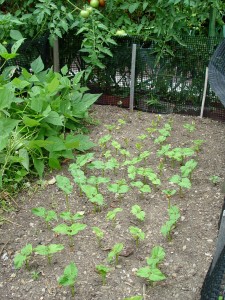Vegetables in Fall
September 3rd, 2009
Don’t be too quick to put your vegetable garden to bed.
We’ve got another 5 or 6 weeks of good growing weather before frost, and cold-tolerant veggies can keep producing well beyond that.
* Why keep going?
You can milk the soil of one more harvest of such September-planted crops as kale, spinach, lettuce, radishes, mustard, collards, mesclun, parsley and maybe even carrots, parsnips, turnips and beets.
Bug problems are generally less in fall (except for cabbageworms), and temperatures and rainfall are usually better than summer.
The cooling days of September and October are more pleasant for gardeners, too.
* Inside tips for fall
Choose varieties that mature as quickly as possible.
“With proper planning, the turn-around time for fall produce can be as early as 60 days or less,” says George Ball, chairman of Warminster-based W. Atlee Burpee and Co.
Two of the fastest: leaf lettuce and radishes. These can go from seed to table in 30 days.
A few inches of chopped leaves around fall crops keep many of them growing into Thanksgiving. Or protect them with cold frames (portable glass- or plastic-covered boxes) or floating row covers (light-weight fabric that drapes right over the plants).
Garlic bulbs planted around Columbus Day will overwinter and mature next July.
Ball suggests timing borderline-hardy varieties so they’re in and out a week before the usual first killing frost in fall. (That’s typically the third week of October in the Harrisburg area.)
Keep in mind, too, that growth slows in fall’s shortening days and cooling temperatures.
* What grows best in fall?
Besides the ones mentioned above, consider broccoli, cabbage and cauliflower. These take a little longer, though, and are best planted mid-August to early September (ditto for Brussels sprouts).
Crops such as kale, Brussels sprouts, carrots and parsnips actually taste better after a frost or two.
* What about the summer crops?
Most of these should be harvested before the season’s first killing frost. Pick tomatoes, peppers, squash, beans, melons and cucumbers before a freeze turns them to mush.
Try protecting a few plants with row cover or a cold frame. We often get a few more weeks of growing weather after that first frost.
* Clean up
As crops croak or get harvested for the season, toss them in the compost bin. The exception is diseased and bug-infested plants. Bag them and set them out for the trash (or burn them if ordinances allow).
Remove all spent plants from the garden so you don’t give cover to overwintering pest bugs.
Then blanket the bare ground with an inch of fresh compost. You can’t beat it for refreshing the soil with nutrition, organic matter and disease-fighting microorganisms.








